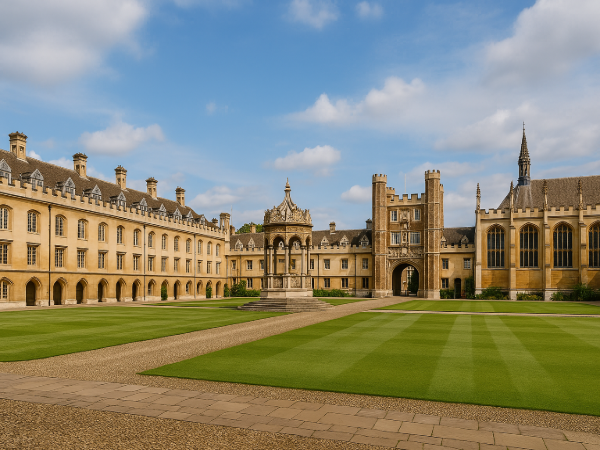Cambridge Courtyard: Exploring the Grandeur of Trinity College’s Historic Heart
Discover the Rich Heritage and Timeless Appeal of Cambridge Courtyard, the Jewel of Trinity College

The Cambridge Courtyard, famously known as the Great Court of Trinity College, stands as one of Europe’s most iconic architectural masterpieces. As the largest enclosed courtyard on the continent, it reflects centuries of academic prestige, historical significance, and cultural tradition. Completed in the early 17th century by Thomas Nevile, the Great Court remains a central hub of Cambridge University, captivating scholars, tourists, and history enthusiasts alike with its symmetrical elegance, age-old traditions, and profound legacy.
The Origin and Vision Behind Cambridge Courtyard
The Cambridge Courtyard did not emerge overnight. Its creation is a story of vision, architectural mastery, and academic foresight. At the heart of Trinity College, one of the largest and most prestigious colleges at the University of Cambridge, lies this majestic square.
The concept of the Great Court was born from the ambitions of Thomas Nevile, Master of Trinity College in the early 1600s. His objective was to create a unified and imposing architectural statement that would reflect the power and influence of the college. Nevile undertook a bold project—reconfiguring and extending existing buildings to form a singular, enclosed court. The outcome was nothing short of extraordinary: a perfect blend of architectural symmetry and academic symbolism.
Architectural Grandeur and Design
The design of Cambridge Courtyard is a masterclass in classical architecture. Covering approximately 1.8 acres, it is reputed to be the largest enclosed courtyard in Europe. Surrounded by historical buildings, the court is a harmonious fusion of Gothic and Renaissance styles, with an air of scholarly majesty that only centuries of intellectual pursuit can impart.
Each side of the courtyard presents its own unique character. The Great Gate, the Chapel, the Hall, and the Master’s Lodge all frame the courtyard with harmonious balance. The detailed stonework, symmetrical layouts, and spacious proportions reflect the grandeur that Thomas Nevile envisioned over four centuries ago.
The Great Court Run: A Timeless Tradition
Among the many traditions associated with Cambridge Courtyard, the Great Court Run stands out as the most iconic. Each year, during matriculation or special events, students attempt to run the full perimeter of the courtyard in the time it takes the clock to strike twelve.
This tradition gained international fame from the film Chariots of Fire, though the scene was not actually filmed in the courtyard itself. Nonetheless, the mythos around the run adds to the court’s mystique and appeal. Successfully completing the run within those brief twelve chimes remains a coveted accomplishment among students.
Historical and Cultural Significance
Cambridge Courtyard is more than just a grand open space—it is a living symbol of British academia. It has witnessed centuries of educational evolution, royal visits, and world-changing scholars who once paced its stone paths.
From Isaac Newton, who conducted experiments in Trinity’s halls, to modern-day Nobel Laureates, the courtyard has quietly stood as a backdrop to greatness. Its very presence evokes a sense of continuity between the past and present, a reminder of the enduring nature of true scholarship.
Events and Daily Life Within the Courtyard
Though historic and revered, Cambridge Courtyard is not frozen in time. It continues to function as an active part of college life. Students and faculty alike use the space for ceremonies, gatherings, and quiet reflection.
The grass at the center is immaculately maintained and largely off-limits to preserve its beauty. Meanwhile, the surrounding paths are a popular site for photos, tourist visits, and alumni reunions. Its blend of serene atmosphere and academic vibrancy makes it unique among university courtyards.
Influence on Cambridge’s Urban Identity
The significance of Cambridge Courtyard extends beyond Trinity College. It has become a symbol of the city of Cambridge itself. Featured in postcards, films, and guidebooks, it epitomizes the city’s blend of historic preservation and academic excellence.
Architects and city planners have often taken inspiration from the symmetry and functionality of the courtyard. Its design principles—open space, balanced structure, and pedestrian focus—are evident in several modern developments within the university and city alike.
Preservation Efforts and Conservation
Given its age and importance, maintaining Cambridge Courtyard is a priority. Conservation efforts are regularly undertaken to preserve the original stonework, wooden beams, and landscaped grounds.
Preservation is not just about maintaining appearances but also about respecting the heritage and spirit of the place. Restoration projects are guided by historians and conservationists, ensuring that every intervention honors the courtyard’s original character while using modern techniques for longevity.
Tourist Attraction and Educational Tours
Cambridge Courtyard is a major draw for tourists from all over the world. Visitors flock to Trinity College to admire the courtyard’s architecture, take guided tours, and experience the atmosphere that inspired some of history’s greatest minds.
Educational tours often include detailed narratives about Thomas Nevile’s vision, the evolution of the buildings, and the traditions tied to the space. It’s not uncommon for visitors to feel a deep connection to the space, as though stepping back in time.
Symbolism in Literature and Art
The allure of Cambridge Courtyard has not been confined to academia or architecture. It has served as a muse for poets, writers, and artists. Its serene beauty and intellectual ambiance have been captured in countless artworks, scholarly essays, and even fictional stories set within its storied walls.
Writers often use the courtyard as a metaphor for intellectual discovery, solitude, or the pursuit of excellence. Whether depicted in oil paintings or novels, Cambridge Courtyard continues to inspire creative expression across genres.
A Lasting Legacy
As Cambridge evolves into the 21st century, the courtyard at its heart remains a steadfast emblem of tradition and excellence. It reminds the world that while technology and society change, the pursuit of knowledge—rooted in places like Trinity College—remains eternal.
The Cambridge Courtyard is not just a physical space; it is an idea. It embodies continuity, excellence, beauty, and a dedication to learning. As visitors walk its perimeter or gaze upon it in admiration, they’re not just witnessing architecture—they’re engaging with history.
Conclusion
In every way, Cambridge Courtyard is a beacon of timeless elegance and intellectual gravitas. From its meticulously designed layout to its storied past and ongoing traditions, it stands as a testament to what a space can represent. For scholars, tourists, and dreamers alike, the courtyard is more than stone and grass—it’s a living, breathing symbol of the pursuit of knowledge.
Whether you’re exploring the heart of Cambridge or reflecting on the power of place in shaping ideas, the Cambridge Courtyard offers an unforgettable journey into the soul of one of the world’s greatest academic institutions.



